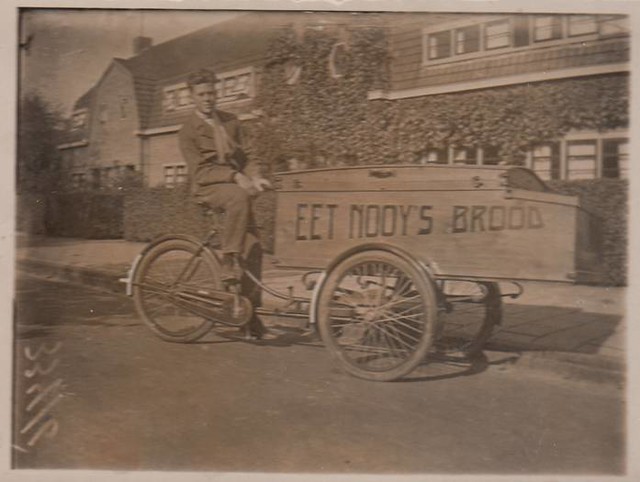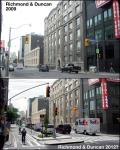Photoshopping of Richmond bike lanes by Mez.
A city councillor is often considered to be a lord over his (or her) own fiefdom aka ward. This is a fairly sturdy tradition in Toronto municipal politics. It's tit-for-tat: I won't interfere with your plans for your ward if you don't interfere with my plans. When Councillor Minnan-Wong announced his plan for a downtown network for separated bike lanes, he upset that unwritten rule.
Even though this tradition can lead to parochialism and a propensity for councillors to only worry about their own re-election instead of the good of the whole city, it also makes some sense as we can see in the following email from Councillor Vaughan to Rob C (props to Rob for forwarding this to me). Vaughan's reasons for opposing Minnan-Wong's plans are that Minnan-Wong is calling for "substantial plans" on these streets, and "completely overrides four years of community consultation and neighbourhood efforts to address the issues on these streets".
From: Councillor_Vaughan@toronto.ca
Sent: January 10, 2011 10:13 AM
To: Rob
Subject: re: Your opposition to separated bike lanes in Toronto
Dear Rob,
Thank you for your email about separated bike lanes. As a resident, cyclist, pedestrian, transit rider and your local Councillor, I am committed to creating complete streets, safe streets and vibrant streets. A number of initiatives over the past four years, that are continuing, demonstrate this commitment.
I think you may be responding to a bike plan floated in the media this week that proposes a series of dedicated bike lanes on a few roads in the ward. It is the same plan that was proposed last summer.
The plan calls for substantial changes to Richmond, St George, Beverley, John, Grange Park and Harbord. All of these streets except for Beverley are undergoing extensive redesign or have just had reconstruction work done on them. John Street and Richmond in particular are in the midst of an Environmental Assessment and a major transportation study.
The proposal not only ignores this work, but it completely overrides four years of community consultation and neighbourhood efforts to address the issues on these streets. The proposal floated in the media would also impact work being done by the Entertainment District BIA, The Art Gallery of Ontario and the University of Toronto. Each of the institutions and organizations are engaged in public realm improvements in the corridor and none have been spoken to regarding the announcement.
Cyclists are a critical part of the ward. Bikes provide a vital transportation service to individuals, families and businesses in Ward 20. Accommodating bicycles is a part of every plan mentioned above. Bicycles are part of every study mentioned above. The proponents of this idea are aware of the situation, but seem more interested in headlines than in working with the community to arrive at a plan.
I am attaching some motions passed last summer by City Council. These motions, presented to the Public Works and Infrastructure Committee by me, do focus on improving bike capacity in the ward. The motions propose 6 new bike lanes in the south part of the ward. These new bike lanes came forward through a Ward 20 community process. The proponents of the other plan have never participated in the Ward 20 Cycling Committee’s work. There are aware of it, but seem more interested in grandstanding than actually talking to the cyclists, residents, businesses and institutions of Ward 20 or doing any work on the projects. It’s a shame. Nonetheless our efforts continue.
As I have said before, the streets of Ward 20 need to be complete streets, safe streets and vibrant streets. We need to find ways to support the choices people make, so that no matter whether you are in a wheelchair, a cyclist, a pedestrian, driving in a car, bus or taxi, or in a stroller, your choice is safe and the road you travel on is beautiful.
The proposal in the news does not accomplish this and therefore should not, and cannot be taken seriously.
av
Councillor Adam Vaughan
Ward 20, Trinity-Spadina
416-392-4044
Some good points. One can't just pull a plan out of thin air and community consultation needs to take place. But it seems like the need for an east-west corridor for cyclists has taken a back seat on Richmond much as it had in the Yorkville reconstruction along Bloor.
I didn't get the attachments Vaughan mentions, though we can see the Ward 20 Cycling Committee recommendations. Vaughan worked with the bike union on forming the committee but it's not clear if he signed off on all the recommendations. Vaughan doesn't mind, however, using it as an example of his successful local consultation.
The Ward 20 report is a useful blueprint, combining a mix of pragmatic with real benefits for cyclists. This report likely gave ammunition for transportation staff to get the bike boxes on Harbord and St. George; and the pilot on-street bike parking on Spadina. It recommended a separated bike lane along University (which was narrowly defeated by a mistaken vote, but was supported by Vaughan).
It's strange, however, that Vaughan is showing off the Ward 20 report, when one of its key recommendations is a protected bike lane on Richmond or Adelaide. Vaughan has his own hope for Richmond and Adelaide to be made two-way, which would likely preclude bike lanes of any sort. Here Vaughan can't claim that the plan was sprung upon him or the community as bike lanes on Richmond and Adelaide have been in the Bike Plan all along.
Rob C. then replied to Vaughan's email:
Hello again Mr. Vaughan,
If you’re wondering where you’re being said to oppose physically separated bike lanes, here’s one rundown:
http://www.ibiketo.ca/blog/origins-and-politics-minnan-wongs-bike-lane-plan
In short, you’re voting against the overall downtown bike plan proposed last year by Heisey, and against the PWIC, because you have proposed your own plan for Richmond/Adelaide which would actually preclude bike lanes.
I notice in your response below that you don’t mention separated bike lanes, which is the issue I was trying to raise, although you use the phrase “dedicated bike lane.” I’m not sure if you’re using the phrases interchangeably. Here’s an informative and interesting video that might clarify the sorts of physically separated bike lanes that have been implemented around the world:
http://www.streetfilms.org/physically-separated-bike-lanes/
You also seem to be suggesting that if the Entertainment District BIA, AGO and U of T were consulted by the media that there might have been insights given as to why dedicated bike lanes are a bad idea.
I cycle to work through all of those areas, I see the developments underway, and I cannot imagine why these organizations might think separated bike lanes would negatively impact their projects and plans. If anything, I see how they would benefit immensely from separated bike lanes, how their areas would be particularly conducive to them, and especially how such lanes would create the exact cultures they’re trying to attract. Check out the video and you’ll see it, just imagine some of those same scenes in the entertainment district, AGO, U of T. They’re a perfect fit.
Again, I would ask you to reconsider your opposition to separated bike lanes such as Heisey’s and Minnan-Wong’s proposals. Please just view the video and then walk around these areas envisioning the impact. Imagine Toronto on par with Paris in terms of culture. At such a low cost too, with almost no down side. And, miraculously, with Ford not opposed to this plan. It’s just too good an opportunity to miss.
Rob C.
Well I wouldn't say Ford was not opposed. I believe he said that he'd support it if it met three objectives: was safe, had community consultation and didn't increase "traffic congestion". We all know that "traffic" doesn't in any include bicycles so that may be a deal breaker for any bike lanes on Richmond.
Just how can we push for improved bike infrastructure (which seems to be happening more slowly than the melting glaciers) and still respect local consultation? There needs to be some balance between local community needs and those of the people passing through. Any plan for separated bike lanes will inevitably undergo some kind of adaptation so that perhaps Vaughan will eventually support some version of this plan.
 ©Bakker Nooy and his bakfiets / bakkerkar
©Bakker Nooy and his bakfiets / bakkerkar ©Brood bakkerij bakfiets - bread bakery cargo bike
©Brood bakkerij bakfiets - bread bakery cargo bike ©artis-bakfietsen-workcycles 6
©artis-bakfietsen-workcycles 6
